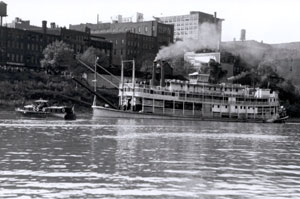
Steamboating
In 1811 the voyage of the steamboat New Orleans ended the silent world of pre-steam Tennessee riverboatmen. When Nicholas J. Roosevelt successfully sailed his wood-fired steam craft down the Mississippi past the Chickasaw Bluffs, the “Steamboat Age” officially began in Tennessee. Actually the voyage of the New Orleans past Tennessee’s western shore proved noisier than Roosevelt expected; the New Madrid earthquake thunderously created or expanded Reelfoot Lake during the passage of the New Orleans. By 1819 the steamer General Jackson had sailed the Cumberland to Nashville; in 1822 the steamer Rocket sailed the Tennessee River to Florence, Alabama. Although the Muscle Shoals of the Tennessee River delayed speedy navigation of that waterway, the once-silent Mississippi, Cumberland, and Tennessee Rivers echoed early with the sounds of the Industrial Revolution.
The workaday Tennessee steamboat was a small, three-hundred-ton, low-draft (drawing only two to three feet) stern-wheeled craft with few fancy trappings and an average life span of five years. Peak shipping time occurred during high water, when steamers carrying flour, pork, whiskey, tobacco, cotton, livestock, and passengers dotted the Mississippi, Tennessee, and Cumberland Rivers. Steamers on these waterways carried crews of twelve, including a captain, pilot, engineer, mate, and deck hands. The men varied in age according to their rank and occupation. The common hands included farm boys, city urchins, and an increasing number of Irish and German immigrants. Free blacks and slaves also worked aboard steamers.
From 1811 until approximately 1830, steamboat commerce increased dramatically and profits soared. Although the steamer Atlas somehow negotiated the Muscle Shoals and arrived in Chattanooga and Knoxville in 1828, most steamer traffic on the Tennessee River was confined to open stretches upstream and downstream from the Shoals. The Knoxville, christened in 1831, ran intermittently between its namesake city and Decatur, Alabama, before the Civil War. On the Upper and Lower Cumberland and the Lower Mississippi business boomed, making the Memphis quay a lively picture of steamers, bustling dockworkers, and cotton bales.
Beginning in 1827, subsidized river improvements, undertaken by the U.S. Army Corps of Engineers, accompanied the increase in steamer commerce. Captain Henry Miller Shreve developed a steam-powered snag-pulling apparatus, mounted to his steamer Heliopolis, that achieved fame on the Lower Mississippi as “Uncle Sam’s Tooth-Puller.” Between 1832 and 1837 Congress allotted $135,000 for snag-pulling on the Cumberland; the state legislature funded navigation improvements on the Tennessee. In 1836 state and federal governments financed the construction of a canal around the Muscle Shoals, but it proved useless to navigation; year-round navigability of the Tennessee remained a dream for another century, until the Tennessee Valley Authority (TVA) and the Corps of Engineers finally conquered the shoals.
After a major setback during the Panic of 1837, the Tennessee steamboat trade stabilized but never regained its earlier profits and glamour. Ironically, as steamers supplanted flatboats and keelboats, railroads poised to cripple all these modes of river commerce. The rise of railroads and the Civil War closed most western river commercial traffic and marked a watershed for the Steamboat Age in Tennessee. Postbellum statistics show a gradual shift in almost every market, except coal, from river to rail transport.
Nevertheless, steamboats did not immediately, or entirely, disappear. Steamers continued to serve the urban centers as well as hundreds of smaller ports and landings. On the Upper Cumberland River, poor roads and the late arrival of the railroads perpetuated a vibrant market for steamers well into the opening decades of the twentieth century. Towns like Carthage, Gainesboro, and Celina boasted a limited, but stable steamboat commerce from the 1850s through the 1920s; in 1925 there were 121 steamboat landings between Carthage and Burnside, Kentucky. Steamers delivered farm equipment and consumer goods to the Upper Cumberland towns and returned to Nashville carrying cargoes of lumber, livestock, farm produce, and passengers.
Elsewhere, steamboat commerce continued, but lost its vibrancy and competitive edge. Tennessee steamboatmen pondered their fate and looked to an increase in subsidized river improvements and the development of more powerful and efficient boats to compete with railroads (and later truckers). The locks and dams of the Corps of Engineers and the TVA and the internal combustion engine redefined river transportation. By the post-World War II era, screw-propellered, diesel-powered, flat-nosed towboats dotted the Tennessee, Cumberland, and Mississippi River Systems that once had hosted the Steamboat Age.
An epilogue to Tennessee steamboating came in the 1970s with the return of the pleasure sternwheeler to the Mississippi, Cumberland, and Tennessee Rivers. The luxurious Delta Queen, American Queen, and Mississippi Queen fire their boilers with diesel oil, not wood or coal, as in the Steamboat Age. And an old steamboatman would certainly feel out of place on boats that boast swimming pools, saunas, movie theaters, and gymnasiums. Yet the sight of these huge pleasure craft, such as the General Jackson in Nashville, conveys a powerful image akin to that of Tennessee steamboating during its antebellum height.



